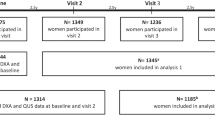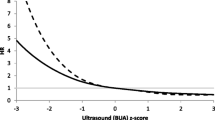Abstract
One of the latest developments in quantitative ultrasound (QUS) is the measurement of the speed of sound (SOS) of cortical bone of the midtibia. To determine the diagnostic validity of this method we measured 150 healthy women aged 22–94 years. Additionally, we report on first results of patients with hip fracture. Precisionin vivo of the tibial QUS expressed as the percentage coefficient of variation (CV) was 0.39% for the first day and 0.45% after repositioning the second day (mean CV=0.42%). No significant dependency of tibial SOS was found with weight, height, and body mass index in pre- and postmenopausal women. There was a significant decline of SOS with age in postmenopausal women (SOS=4225–5.3 age, r=−0.46,P<0.001), whereas premenopausal women showed no decline (SOS=3906+1.3 age, r=0.13, ns) Mean SOS values of premenopausal women were significantly higher than those of postmenopausal women (3960±78.7 m/second and 3898±120 m/second, respectively,P<0.001). Postmenopausal women on estrogen substitution had significantly higher mean tibial SOS values than age-comparable postmenopausal women without estrogen substitution (3980±99 m/second and 3869±100 m/second, respectively,P<0.001). Significant difference between age-matched healthy women, n=11, and hip fracture patients, n=13, expressed as z-score of −1.4 SD was found. In conclusion, tibial QUS declines with age and detects higher values in premenopausal women and postmenopausal women on estrogen substitution and lower values in hip fracture patients. Further prospective studies are needed to clarify its role in fracture risk assessment.
Similar content being viewed by others
References
Reiners C (1991) Nicht-invasive quantitative Knochendich-tebestimmung. In: Ringe JD (ed) Osteoporose. De Gruyter, Berlin, pp 157–216
Need AG, Nordin BEC (1990) Which bone to measure? Osteoporosis Int 1:3–6
Cummings SR, Black D (1986) Should perimenopausal women be screened for osteoporosis? Ann Int Med 104:817–823
Melton LJ III, Wahner HW, Riggs BL (1988) Bone density measurement. Ann Int Med 108:481–482
Tavakoli MB, Evans JA (1991) Dependence of the velocity and attenuation of ultrasound in bone on the mineral content. Phys Med Biol 36(11):1529–1537
Heaney RP, Avioli LV, Chestnut CH III, Lappe J, Recker RR, Brandenburger GH (1989) Osteoporotic bone fragility: detection by ultrasound transmission velocity. JAMA 261:2986–2990
Waud CE, Lew R, Baran DT (1992) The relationship between ultrasound and densitometric measurements of bone mass at the calcaneus in women. Calcif Tissue Int 51:415–418
Genant HK, Faulkner KG, Glüer C (1991) Measurement of bone mineral density: current status. Am J Med 91 (suppl 5): 49–53
Goldstein SA, Goulet R, McCubbrey D (1993) Measurement and significance of three-dimensional architecture in the mechanical integrity of trabecular bone. Calcif Tissue Int 53 (suppl 1):127–133
Glüer CC, Wu CY, Jergas M, Goldstein SA, Genant HK (1994) Three quantitative ultrasound parameters reflect bone structure. Calcif Tissue Int 55:46–52
Turner CH, Peacock M, Timmerman L, Neal JM, Johnston CC Jr (1995) Calcaneal ultrasonic measurements discriminate hip fracture independently of bone mass. Osteoporosis Int 5:130–135
Mautalen C, Vega E, González D, Carrilero P, Ontaño A, Silberman F (1995) Ultrasound and dual x-ray absorptiometry densitometry in women with hip fractures. Calcif Tissue Int 57:165–168
Bauer DC, Gluer CC, Genant HK, Stone K (1995) Quantitative ultrasound and vertebral fracture in postmenopausal women. J Bone Miner Res 10:353–358
Yamazaki K, Kushida K, Ohmura A, Sano M, Inoue T (1994) Ultrasound bone densitometry of the os calcis in Japanese women. Osteoporosis Int 4:220–225
Stewart A, Reid DM, Porter RW (1994) Broadband ultrasound attenuation and dual energy x-ray absorptiometry in patients with hip fractures: Which technique discriminates fracture risk? Calcif Tissue Int 54:446–469
Wallach S, Feinblatt JD, Avioli LV (1992) The bone “quality” problem (editorial). Calcif Tissue Int 51:169–172
Wapniarz M, Lehmann R, Banik N, Radwan M, Klein K, Allolio B (1993) Apparent velocity of ultrasound (AVU) of the patella in comparison to bone mineral density at the lumbar spine in normal males and females. Bone Miner 23:243–252
Young H, Howey S, Purdie DW (1993) Broadband ultrasound attenuation compared with dual-energy x-ray absorptiometry in screening for postmenopausal low bone density. Osteoporosis Int 3:160–164
Herd R, Ramalingham T, Ryan P, Fogelman I, Blake G (1992) Measurements of broadband ultrasonic attenuation in the calcaneus in premenopausal and postmenopausal women. Osteoporosis Int 2:247–257
Vesterby A, Mosekilde L, Gunderson H, Melsen F, Mosekilde LE, Holme K, Sørensen S (1991) Biological meaningful determinants of in vitro strength of lumbar vertebrae. Bone 12: 219–224
Wüster Chr, Paetzold W, Scheidt-Nave Chr, Brandt K, Ziegler R (1994) Equivalent diagnostic validity of ultrasound and dual-x-ray-absorptiometry in a clinical case-comparison study of women with vertebral osteoporosis. JBMR 9 (suppl 1): A384
Butz S, Wüster Chr, Scheidt-Nave Chr, Götz M, Ziegler R (1994) Forearm BMD as measured by peripheral quantitative computed tomography (pQCT) in a German Reference Population. Osteoporosis Int 4:179–184
Lilley J, Walters BG, Heath DA, Drolc Z (1991) In vivo and in vitro precision for bone density measured by dual-energy x-ray absorption. Osteoporosis Int 1:141–146
Libermann UA, Rimon AB, Keinan D (1995) Ultrasound measurements along the tibia: age-related changes in normal female and male populations and correlations to postmenopausal osteoporotic (PMO) patients. Bone 16 (suppl 1):A148
Foldes AJ, Popovtzer MM (1995) Ultrasonic measurements of the tibia: clinical evaluation. Bone 16 (suppl 1):A150
Wüster Chr, Brandt K, Paetzold W, Scheidt-Nave Chr, Leidig G, Götz M, Ziegler R (1993) Ultrasound of the os calcis for osteoporosis risk assessment. JBMR 8 (suppl 1):A955
Orgee J, McCloskey EV, Foster H, Coombes G, Khan S, Kanis JA (1994) Tibial ultrasound velocity—a useful clinical measure of skeletal status. J Bone Miner Res 9 (suppl 1): A143.
Damilakis JE, Drettakis E, Gourtsoyiannis NC (1992) Ultrasound attenuation of the calcaneus in the female population: normative data. Calcif Tissue Int 51:180–183
Wüster C, Duckeck G, Ugurel A, et al. (1992) Bone mass of spine and forearm in osteoporosis and in German normals: influence of sex, age and anthropometric parameters. Eur J Clin Invest 22:366–370
Mazess RB, Barden HS (1990) Interrelationships among bone densitometry sites in normal young women. Bone Miner 11: 347–356
Lehmann R, Wapniarz M, Kvasnicka HM, Klein K, Allolio B (1993) Velocity of ultrasound at the patella: influence of age, menopause and estrogen replacement therapy. Osteoporosis Int 3:308–313
Naessén T, Mallmin H, Ljunghall S (1995) Heel ultrasound in women after long-term ERT compared with bone densities in the forearm, spine and hip. Osteoporosis Int 5:205–210
Schott AM, Weill-Engerer S, Hans D, Duboeuf F, Delmas PD, Meunier PJ (1995) Ultrasound discriminates patients with hip fracture equally well as dual energy x-ray absorptiometry and independently of bone mineral density. JBMR 10(2):243–249
Alenfeld FE, Wüster Chr, Beck C, Ziegler R (1995) Diagnostic value of ultrasound measurements of bone mineral density on the metacarpals in healthy and osteoporotic subjects. Bone 16 (suppl 1):A247
Wüster Ch, Pereira-Lima J, Beck C, Götz M, Paetzold W, Brandt K, Scheidt-Nave Ch, Ziegler R (1995) Quantitative ultrasdiale densitometric (QUS) zus osteoporose. Risiko, Beusteilung, Refereuzdateu für versduedeue Meßstellen. Grenzeu und Gusatzmoglidikeiten. Der Frauenarzt, 1304–1314
Author information
Authors and Affiliations
Rights and permissions
About this article
Cite this article
Funck, C., Wüster, C., Alenfeld, F.E. et al. Ultrasound velocity of the tibia in normal german women and hip fracture patients. Calcif Tissue Int 58, 390–394 (1996). https://doi.org/10.1007/BF02509435
Received:
Accepted:
Issue Date:
DOI: https://doi.org/10.1007/BF02509435




